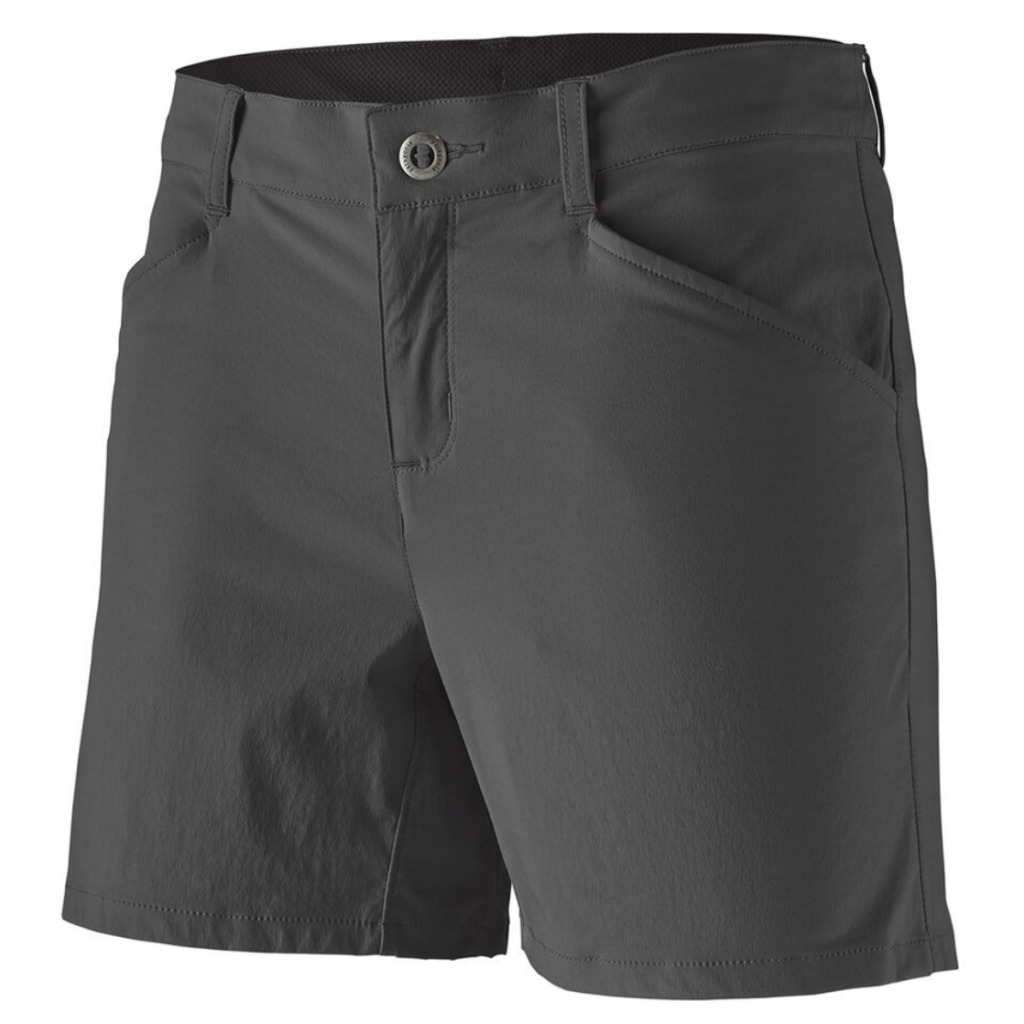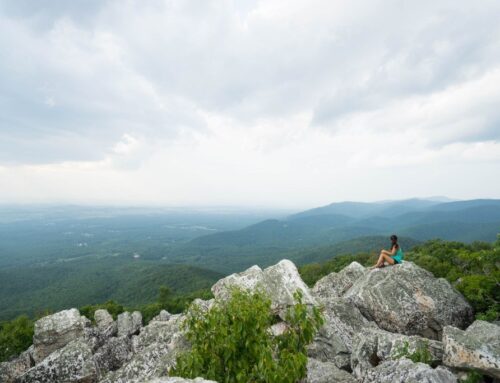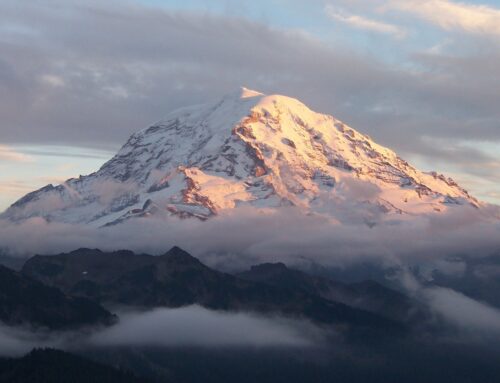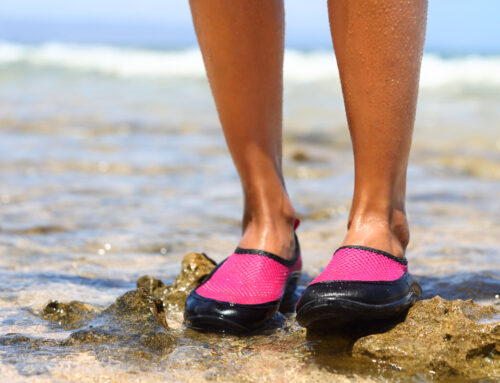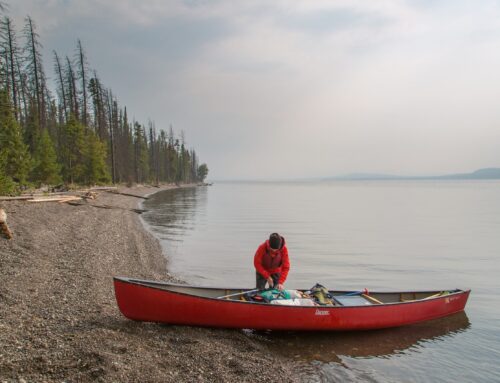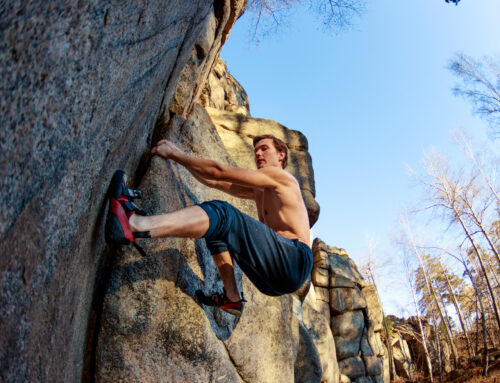Updated May 4, 2021
We love hiking because it’s an activity that typically doesn’t require special expertise or equipment. With that said, using durable, comfortable hiking clothes and gear can greatly improve your experience on the trails, especially if you’re planning on doing longer day hikes or overnight backpacking trips. Additionally, wearing the right clothing for hiking is important for your safety, especially in rural alpine climates where the weather can turn in an instant. To help you create the perfect hiking wardrobe, we’ve created this comprehensive guide so you know exactly what to wear hiking during any season or occasion.
Generally, the name of the game for hiking clothes can be described in one word: layers. With the right sets of breathable, sweat-wicking layers for each season, you can mix and match pieces to fit the conditions you’ll be hiking in. We’ve spent several years testing hundreds of different hiking clothes in several destinations around North America to put together this list of our top gear recommendations.
Essential Hiking Clothes for Men and Women
There are a few essential hiking clothes you should have in your closet for any season, climate, and terrain. These items are perfect for layering or wearing on their own, so you’ll be prepared for any kind of temperatures or surprises you’ll encounter on the trails.
Sweat Wicking Underwear/Sports Bra
While often forgotten in hiking gear lists, the clothes that sit right next to your skin – AKA your underwear – are arguably the most important ones to think about for your comfort. You’ll want to choose underwear that’s sweat-wicking and quick dry, so you won’t be stuck with the dreaded “swamp a$$” when hiking long distances or fording a river or creek (yup, it’s a thing).

For women, we recommend the Patagonia Barely Sports Bra and the REI Active Hipster Underwear for all-day support and sweat wicking. These are two of our absolute favorite undergarments to wear with any hiking clothes for the most comfortable experience on the trails.

For men, we recommend the Smartwool Merino 150 Boxer Briefs for long days on the trails. They’re sweat wicking, breathable, and perfect for wearing under shorts or hiking pants for a long day of hiking.
Breathable T-Shirt or Tank Top
For any adventure, you’ll want the comfiest, driest fabric sitting closest to your skin. We love and strongly recommend Merino wool products for any hike, summer or winter, because of its breathable, sweat-wicking, stink-free properties. We love SmartWool products because of their versatility and durability, but they are definitely an investment.


For women, we recommend the Womens Smartwool Merino 150 Base Layer t-shirt and tank top. We’ve loved hiking in these items in spring, summer, fall, and even winter because they stay dry even when layered underneath several other items of clothing.
(Editor’s note: I love wearing my Smartwool tank top with a pair of nice leggings or jeans when I’m shopping or meeting friends for coffee…it’s SO comfortable!)

For men, we also recommend the Smartwool Merino 150 Base Layer for a light, dry t-shirt that stays sweat-proof and stink-free all day. As an added bonus, these shirts are perfect for working out at the gym, going for a jog, or running errands on a weekend morning.
Hiking Pants/Leggings
In our opinion, your pants are the most important item of clothing to consider when planning what to wear hiking. Generally, you’ll want hiking pants that are flexible, durable, and don’t cause chafing or stiffness so you can move over rocky areas, scrambles, and steep ascents with ease. This means pants like jeans, khakis, thick sweatpants, and other inflexible or non-breathable fabrics are generally not great choices for adventures on the trails.
We recommend wearing long pants or leggings in areas with lots of mosquitoes and ticks, as well as poison ivy and poison oak. These common skin irritants can cause massive discomfort on long hikes, and wearing pants is the easiest way to avoid contact with them.

Our favorite women’s hiking pants are, hands down, the Halle Pant from PrAna. They’re super comfortable and stretchy, and are made out of PrAna’s Zion fabric, which is durable and sweat-wicking. Used by both hikers and rock climbers for all kinds of rugged adventures, we don’t go anywhere outdoors without these pants.

For men, we strongly recommend the Brion Pants from PrAna. Our rock climbing expert loves these for bouldering, and similarly they are fantastic for hiking, too. They’re stretchy and light, but are also quite durable for those jagged scrambles and rocky scree trails that you’ll inevitably face at some point in your hiking journey.
In hot weather, you may want to opt for shorts instead of pants on your hikes. There are many types of hiking shorts for women and men that you can choose from, depending on your hiking style and your personal preferences.
Thermal Long Sleeve
A thermal long sleeve is a must for any hiker, especially for colder times of the year or higher altitudes. Don’t be fooled – several summit hikes can reach below freezing even in the summertime! The best thing about these lightweight long sleeve shirts is that they’re compact enough to throw into your backpack and put on as you gain elevation (or if the weather becomes chilly as you’re on the trail).

Our favorite thermal long sleeves are from the SmartWool Merino 250 line (for women and men). They’re super cozy, soft, and warm, and they keep stink away for days. We’ve tested this out on 14ers in Colorado, trekking through Patagonia, and day hikes in Banff, and it has remained one of our staple recommendations for what to wear hiking.
Thermal Jacket
While you won’t need to bring or use this all the time, it’s a good idea to keep a thermal jacket handy in your car or closet for colder weather hikes. For a thermal hiking jacket, there’s nothing better than a simple fleece quarter zip or full zip to keep you warm and dry over your base layers.

For cooler hikes, we use and recommend the Patagonia Better Sweater Quarter Zip (for men and women) because it’s durable, warm, packable, and washable. (Editor’s note: This fleece jacket has kept me warm on fall nights camping, snowy alpine trails, and long winter runs in Chicago. One of my favorite pieces of gear, period.)
Rain Shell
The worst situation in hiking is getting stuck in the rain without being prepared. A waterproof rain shell is a must for hikers, no matter where you’re headed. Unfortunately, many “rain shells” are actually not completely waterproof, and we’ve had several bad experiences being stranded in the rain in a new rain jacket that left us soaked to the bone.

The North Face Venture rain jacket (for women and men) is our favorite pick for a hiking rain jacket because it’s completely waterproof, yet lightweight and packable for long days on the trails. Our North Face Venture jackets have kept us dry during thunderstorms at Machu Picchu, on rainy afternoons in Slovenia, and while hiking in Grand Teton National Park.

Breathable Trucker Hat
There are lots of different kinds of hats you can wear hiking, and which one you choose will largely be based on your personal preferences. However, we’ve found that trucker hats are by far our favorite hats to hike in because the breezy mesh backing prevents your head from getting too sweaty. These hats help you avoid sunburn on your face without weighing you down with too many cords or too much fabric. Don’t forget a good pair of polarized sunglasses for sun protection, too.
Hiking Socks
Your feet get the most impact from a long day of hiking, and making sure they’re comfortable and cozy in your shoes is the key to a seamless hike. A thick pair of wool hiking socks is what we’d recommend for most trails that are longer or require some serious elevation gain.

We use and recommend Darn Tough and Smartwool socks for our day hikes and backpacking trips. Merino wool socks keep our feet warm and dry, and both of these brands make socks made to last through even the toughest long trails. If you’re prone to blisters from hiking, we’d also recommend a pair of hiking sock liners to go underneath your socks and help prevent chafing.
Hiking Boots
This should be a no-brainer, but we can’t have a list of what to wear hiking without them: sturdy hiking boots. While some people prefer to hike in trail runners, we’d recommend owning at least one pair of classic, ankle-height boots for your more intense hikes.

When you’re considering a new pair of boots, we always suggest visiting your local REI or at least trying on a few pairs of hiking boots from several different brands before you buy. With that said, we love our Salomon hiking boots for long hikes and backpacking adventures – they’re not too expensive, come in waterproof styles, and have plenty of support for rocky and uneven terrain. If you want to splurge for a more classic, leather-upper look (and a price tag to match), there are few shoes more beautiful or comfortable than the Danner Mountain Light boots.
Buff and/or Face Mask
Hiking in today’s global circumstances remains a fairly safe activity, but taking precautions to protect yourself and your community is extremely important, especially on crowded trails. Despite being outdoors, we recommend bringing a face mask or Buff on all hikes to wear in congested areas or when you know you’ll be in close proximity to other people.

A Buff is a circular piece of stretchy fabric that many hikers (men and women) swear by. We recommend it because it is a perfect double-whammy between a face mask and a multi-purpose hiking gear item that can be used as a dust filter, a headband, a scarf, and more. It’s a little thin, so for maximum mask effectiveness, we recommend folding it over itself so that you have two layers of fabric over your nose and mouth near others. Alternatively, you can simply buy a washable face mask and use it in crowded areas.
What to Wear Hiking in Warm Weather
Hiking in warm weather means more heat and therefore, more sweat. In addition to the essentials above, we recommend having the following warm weather hiking clothes for your summertime adventures!
Hiking Shorts
On the hottest and most humid days of summer, pants will likely feel suffocating on your legs. For these days, we’d suggest wearing a pair of hiking shorts on your adventures.


However, if you’re looking for a practical pair of hiking shorts, we recommend the Women’s Olivia Shorts and the Men’s Zion Shorts by PrAna for hiking. Just like PrAna’s pants, these shorts are breezy and lightweight, and have several pockets for you to store gear, snacks, wallets, and more. In hot weather, women can also opt to wear a hiking skirt, which provides more breathability and range of motion than many pairs of shorts do.
Swimsuit
Many hikes that border rivers or lakes have areas that are suitable for swimming, and this is a fantastic way to cool down from a tough trail! For these hikes, we’d recommend packing a swimsuit or wearing one underneath your hiking gear so you’re ready to jump in the water. We’d also recommend a lightweight microfiber quick dry towel so you can dry yourself off before you hike again.

Active Sandals
Sandals are certainly not appropriate for every hiking scenario, but a tough pair of hiking sandals can be useful for easier, flatter trails or hikes that include several water crossings. We love our Chaco Z/Cloud sandals for non-technical summertime adventures and cold dips or stand up paddle boarding in the lake after a long day hike.
What to Wear Hiking in Cold Weather
Cold weather hiking can be a completely different game than summertime hikes. Why? Because staying warm, especially at high altitudes, can be a real challenge. In addition to the essentials above, we’d recommend the following hiking clothes for winter adventures.
(By the way, we’ve got an entire guide to our best winter hiking tips and gear essentials – don’t forget to check it out!)
Compressible Down Jacket
A compressible down (or synthetic) jacket is the perfect layering piece for cold weather hiking. It’s thick enough to provide significant extra warmth, but compact enough to layer underneath a rain jacket or windbreaker.

Our go-to recommendation for a compressible down jacket is the Patagonia Down Sweater (for men and women). It’s super comfortable and warm and compresses down to the size of a Nalgene bottle. (Editor’s note: Mine is so comfy I often sleep in it!) Perfect for cold mornings camping or high-altitude summits, this compressible down jacket is one of our staple cold weather hiking pieces.
Thermal Leggings
In the coldest times of the year, regular hiking pants won’t be enough to keep you warm. You’ll need a pair of thermal leggings to wear underneath them to keep your legs nice and toasty.

Smartwool has warm thermal leggings for men and women that were specifically designed for cold weather outdoor activities. They work best as baselayers underneath hiking pants, but you can even wear them on their own.

Gloves
Your extremities are the most susceptible to cold temperatures, so it’s important to protect them if you’re planning to spend time outdoors in the winter. We use and love the e-Tip Gloves by The North Face for all of our winter outdoor activities – running, hiking, biking, and more.

Beanie
In the winter, a regular mesh trucker hat definitely won’t protect your head from the bitter cold, so you’ll want to hike with a beanie that covers your ears. This is important, because your ears can easily get cold or suffer from frostbite if not taken care of. There are tons of cozy beanies on the market, but we’d recommend a Merino wool beanie because it’s lightweight, less likely to stink, and the fabric will be more breathable than cotton.
Crampons/Spikes
During the colder times of year, it’s a good idea to bring a pair of crampons in case you encounter lots of ice or snow on the trail. Crampons are basically spiked chains that you attach to your shoes help you walk on slippery, icy areas, giving your foot more traction in the cold than a regular rubber sole would. There are lots of different types of crampons out there that you can buy for more technical winter hiking, but a pair like these should be sufficient for the majority of recreational winter hikers.

